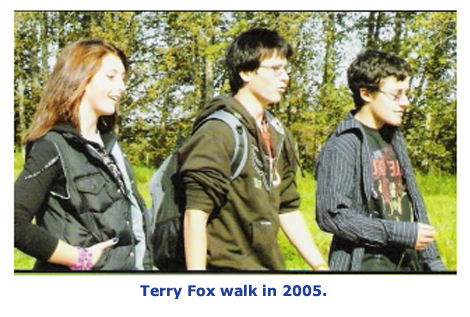
The growth of the number of pupils in the elementary school caused a demand for room and, in a short time all arrangements had been made for the establishment of a High School. The High School was organized in the King’s Hall in September of 1923, with an enrollment of 60 pupils. Meanwhile, the Board under the chairmanship of Mr. Ostrosser urged forward the construction of the present High School building that was completed and fully equipped in time for the opening of school in September 1924. The number of pupils enrolled in the second year increased to 97 and at the end of the school year to 105. The number of pupils enrolling in September 1925 again showed an increase to 150 and by September 1926, the number had increased to 199.
Every room in the High School was now full and some seriously overcrowded. The Board was now faced with the ever-occurring problem of what to do with prospective entrants for 1927. After careful consideration it was decided the best thing to do was to build a Technical Branch in order to relieve the congestion in the High School, and afford the opportunity of technical training to the pupils of Timmins and the surrounding area.
Good progress has been made towards this end, and it is expected by the January 1, 1928 a new era began for secondary education in Timmins when Timmins High School opened as the Timmins High School and Technical Institute.
As the amount of students continued to increase, further additions were made to the school until 1980, when a new school building was constructed at its present location (451 Theriault Boulevard).
Learn more about Timmins High throughout the years by clicking through our history timeline below, starting with the 20's & 30's.
20's & 30's
The Twenties - Those Were The Days
Written by Minerva Levinson Gram for the Homecoming 1980 Yearbook
Hello, old friends - and welcome back! With much pleasure and nostalgia I “take pen in hand” for a trip
through the halls of dear old Timmins High BEFORE it became Timmins High and Vocational School - 200 students grand total - year 1927.
My first and most debasing experience upon arrival was being shoved into a roomful of squirming and
screaming first-formers. I had asked the Janitor where fourth-formers were to meet. He took one look at
me and snorted:”Fourth formers! FIRST-formers is what you want! In here!” (I must admit he apologized
graciously later, and even put a mirror in the girls’ washroom at MY eye level, by way of amends.)
The halls! The camaraderie, laughing and
jostling. I can still see Margaret (Peggy) McPhail
with that majestic walk. She never seemed to
hurry, yet she was always on time. Tall, lithe
Ethel Allworth going down the hall - usually with
myself - we were inseparable. I can still hear the
whispered “Mutt and Jeff” as we passed but
always in fun.
The time I caught my heel and literally flew down
not ONE, but TWO flights of stairs. Were it not
for sturdy Mr. Henry, our Math teacher, who
caught me I might STILL be rolling down those
corridors. It was a good thing that an irresistible force DID meet an immoveable object.
More recollections rush in! Jenny Farley fainting on the doorstep of our room after writing a “trig” exam. No wonder! When the papers were returned, hadn’t she scored a hundred! And the “Lits” – Sonia Charron
and Edna Poitras’ beautiful voices still linger in my memory. The High School Orchestra! Jimmy
Ormston on piano; Len Caveney and Gino Biondi, the brass; Harold Craig on drums and Bill Shub, David
Payne and myself, the strings.
And what would school be without those special
memories of teachers - some favorite - some
otherwise! Of course, on maturing, we realized
that some of us were favorites, some otherwise
too!
Mr. Treleaven, our principal and Latin teacher, a
kindly man, was “semper fidelis” to us, but I’m
afraid found us not “semper paratus” for him!
Miss Garbutt had a fine sense of humor PLUS a
decided ability to get French across.
Mr. S. E. Henry, who for me, epitomized the couplet he put in my autograph album - “If you can’t see
the bright side of a thing, polish the dull one.” I’m sure no but he could have seen me through Geometry. Miss Rutherford, who made History live and who was a tower of strength when I innocently took on the
Editorship of the very first Porcupine Quill. Her quotation in my autograph album still haunts me - “Not
failure - but low aim - is crime.”
I never see, in my mind’s eye, Vera Mustato without associating her lines in my autograph album:
You can’t own life, you can only live it, Your can’t own Love, you can only give it,
You can’t own Truth, truth would die unheard,
I think that OWN is a foolish word!
How true, even today.
As I leaf through the pages, I see lines in Italian, German, Ukrainian, French, Latin Greek, and Finnish,
and realize that this is what made us so unique. The warp and woof of the area were woven into the
mosaic that made us one, yet kept us different.
Ah yes, P.T. not Phys. Ed., as it is called today. Here I was
introduced to Basketball and black eyes, simultaneously. At that
time in the game, there was a running centre - me, on our side. My counterpart, Elsie Henderson, was long and lean, with elbows
to match. I ran right into both of them the first time I was on the
court. How I was twitted about “running into a door”. Doug
Carriere, who became a life-long friend, introduced me to tennis. I can still remember coming into Science class with him and
talking over a match so excitedly that Miss Lillie Quinn brought
us back to the present by clapping two retort flasks together so
sharply that I fell right off my stool. Doug had to yank me back
up again. Undoubtedly, Miss Quinn was one of the finest and
most-loved teachers TH&VS ever had.
Why something else intrudes upon my memory here I don’t know, but it does – the inequities of our
transportation system. Schumacher had no Continuation School, so their students bussed right to the door.
South Porcupine did have one, so only the final year students had to go to Timmins. Since there were only
eleven of us, we did not warrant the hiring of a bus by the Board of Education. We had to catch the
regular bus and get off at Dalton’s (where Woolco is now located) and make our way on foot, to the
school. Several dogs took it upon themselves to form “friendly?” packs to waylay us, so we had to devise
devious routes to elude them.
Those long cold treks bring to mind an episode that happened the following year when I took the
“Commercial Special”. I had just arrived, with frozen fingers, to be told to hurry, as we were going to
have a speed test in typing. You can imagine the results! For several years, with my name prominently
mentioned, that disastrous display served as a prime example of what NOT to do! Yet, something very
Girls Basketball Team in 1929
important was gained from that experience too I made it a point throughout my subsequent teaching
career not to ridicule my pupils - ever!
The images that slip through my mind - racing for expression - Alma Tario winning the Senior Girls’ Championship and Jack Len, the Senior Boys’; a little red head in Grade Nine, Kitty Duxfield, doing the
Irish Jig for a “Lit” program; and the whole Senior Room taking off one fine afternoon to see “Seventh
Heaven” with Janet Gaynor and Charles Farrell. How the girls cried through the performance!
The many times I went home with Rose Bucovetsky for supper, with the father admonishing the children
in the same manner and words as Miss Rutherford: “Not failure, but low aim, is a crime.” What a fine
rapport the parents had with their family!
I still chuckle every time I read Tomye Church’s account of the 1928 Cavalcade on the official opening of
the Ferguson Highway. His autograph reads: “Let me hold in a frame of silence your picture as my
friend.” But how could one ever equate Tomye and silence?
I remember the keen wit of Pat Murphy and Tom Cooper, and Walter Boyle’s wide grin. What a
delightful surprise to meet Jack Cuthbertson after a lapse of fifty-one years. He astounded me by quoting
verbatim the verse he had put in my autograph album:
Read these words so true and wise,
That comes from an intelligent sage.
Minnie, never act your size,
But always act your age!
Faces upon faces - Manny Abrahms, charismatic and witty - it was she who not only
was responsible for naming our yearbook “The Porcupine Quill”, but also won the
contest for naming the newest Ansara ice cream parlor “The Golden Hub”. I see Eliza
Cushing’s blue eyes and Alice Habib’s deep soft brown ones. I hear Petty Smith’s
ironic wit. She should have written a book on “snappy comebacks”.
With pride, I hear Roy Sharp receiving the “Lamp of Learning” from the City of
Timmins for his outstanding contribution to education. We had a grand reunion a few
years back, when Basil Davis brought him over for a visit. I remember reading, with
great pleasure, after many intervening years, an article by Horace Brown with
whom I was not only in Grade One but also in Fourth Form.
Yes, we lived through the riveting and other noises of school expansion. We learned through the years to
rationalize our ideals with life’s realities, and thus come to terms with ourselves. And so, we have met
destiny had on!
To TH&VS, I’m sure we are all grateful. For you, in part, are responsible for the way we learned to
“cope”. Hail and farewell
Principal's Summary for 1928-29
Written by J.W.R. Treleaven, Principal. First appeared in Porcupine Quill, 1928-29
An annual summary of the work of the school has become one of the features of your valuable school journal.
The year just passed has been one of constructive building. During the past year the
Commercial classes have been organized for the first time on the lines
recommended by the Department of Education. This will permit, next year, the
addition of regular classes in third year science, and will make the Commercial
course complete in all details. The course as now planned will be complete in itself, and will include in addition to purely Commercial subjects: English Literature and
Composition, Elementary Science, History and Geography.
The board has been fortunate in securing the services of a most effective and
capable teacher of English and History on the technical side. Some of the pupils in
C3 will write on the English papers for matriculation and this practice will grow
more popular from year to year. Miss Garrow’s work in History and English has met with strong approval.
The Commercial Department under the direction of Miss Gowan and Miss McNamera is one of the most firmly
established of the vocational courses and seems to be meeting a real need in the community. The Entrance
requirement for this course is the High School Entrance certificate.
During the year the Department of Household Economics has made good progress and has become well established
under the direction of Miss Halliday. This course is bound to grow in popularity as the advantages it offers become
better known. Sewing, cooking, Home-Nursing, Home Economics, Art, Dietetics, Literature, Composition,
Arithmetic, Geography, History, Science, are all involved in the course and any girl wishing to specialize in nursing
is advised to take this course. It is a three years’ course and the Entrance requirement is the High School Entrance
certificate, though pupils of Fourth Book standing may be admitted in Pre-Vocational classes on passing a special
examination in Arithmetic, Grammar, Spelling and Composition. This examination will be held about the same time
as the Entrance examination.
All pupils wishing to enter the Technical School should pass the Entrance
examination. It is true that the Department makes special provision for the admission
of Pre-Vocational pupils Fourth Form grade, but henceforth their work will be
restricted almost entirely to completion of their academic work which could be done
better in the lower school. The work of the more advanced pupils of the Technical
School, especially the classes in the Machine Shop, Wood-working, Electricity and
mining has proven very successful during the year and makes promise of good
progress in the future. The aim of these classes is to prepare pupils for administration
to their skilled trades or to help them find out what vocations they are best adapted by
taste and training. As the classes increase in numbers, the course will conform more fully to the outline provided by
the Department of Education, and will be complete and organized as the other vocational courses. The progress
made by several classes this year has been entirely satisfactory.
The spirit of earnestness, the growth of discipline, the regularity and high percentage of attendance which has been
due to the increasing popularity of the school and its courses, give every promise of continued success and
effectiveness.
The Thirties
Written by Ray Eddy, for the Homecoming 1980 Yearbook
My last year at TH&VS (1933-34) was perhaps the most memorable year in my life; a very enjoyable climax of my years at the school. That year I was elected President of the Literary Society and managed the production of the Porcupine Quill.
Campaigning for the Presidency of the Lit Society created more furor than Timmins High had seen for many years. Bob Hogarth, Dave Sky and Jack Brovender were my campaign directors and if I had managed to keep them around for the rest of my life in that capacity, I probably would have gone further in the political field than I did. They were marvelous organizers. On Page 48 of the Porcupine Quill is a small mention stating “Eddy for President - was written on every blackboard”. Well, that is a little understated - the fact is that each morning and lunchtime when we returned to the classrooms, both boards in all form rooms were completely covered with the slogan. These three fellows must have had unlimited help and I suspect a bit of sanction from the teachers who were known to proceed very slowly to their classrooms where they knew the chalking was going on.
I always arranged to be about the last one in the room and you can imagine how disturbing it must have been to the teachers to put up with 40 odd students clapping and calling out “Speech – Speech” - not once a day - but with every change of classroom as we were on the rotary system.
I had several very worthy opponents and once I got over the embarrassment, I became very adept at making more and vaguer promises than any of them - and with the splendid artwork caricatures and cartoons that constantly showed up around the school, drawn by Harry Shephard and Arthur Pritchard, and the general feeling of tremendous enthusiasm, we won the election by a landslide.
We did many things that year, such as staging plays, debates, etc. and I can still remember the dark blue velvet curtains on the stage - which I was usually in front of, being master of ceremonies, and being somewhat inarticulate in those days as I have been all my life since, my fellow students didn’t miss any opportunities to trip me up - either by repeating four or five words I just said over and over behind the curtain or holding the curtain closed when I had just finished my introduction or whatever and wanted to get off the stage. I was even stuck by a hat pin one time, in the part of me that was leaning against the curtain.
An interesting thing about the Student Council or Literary Society in those days, was that we were completely self-supporting - not in any way subsidized by the school, so we ran money-making projects, many of which were dances. Two or three a year of three dances were important community events. I recall at one of these evenings Bill Drew was in charge of ticket sales and late in the evening he ran out of change, so he solved his ticket selling problem by the simple expedience of flipping the customers double or nothing to get in – so the $1.50 charge often became $3.00 per couple.
We always served lunches at these big dances and the domestic science students would make the sandwiches in the science kitchen - we would
buy the groceries.
Mr. Bernardi at Timmins Dairy was persuaded to donate about half the whipping cream we put in the coffee. An incident that stands out in my mind is that one evening, a person who had never made 45 gallons of coffee before (we had three 15 gallon enamel pots) put the coffee in cheese cloth in the containers, then added the cream and sugar and proceeded to boil the whole mess. Rather than admit we were that stupid and have to do without coffee, we got a bolt of cheesecloth from the sewing room and strained all the curds out of the coffee. Needless to say, there were many compliments about the coffee and the Domestic Science room floor got a good mopping up - some of us lost a good two hours dance time because of the incident.
The Lit Society that year was such an enthusiastic body that we decided to publish a year book. Since we hadn’t done one for four or five years, there were very few precedents available to us and we were all completely without experience.
3I had the invaluable experience of picking the right people to work together and get a very large undertaking completed and published against a deadline and made it a literary and financial success. Ernie Hogarth and I looked after the financing and it was our purpose to sell enough advertising that we would be able to give the magazine away and while we did very well, at the end we were obliged to charge the very small sum of twenty-five cents per copy.
The revival of the Quill was a team effort from the word “go”; everybody helped the others. It was during depression years and the school staff was very concerned that we would lose money on the effort. My responsibility was to sell advertising on Saturdays and after school. I sometimes skipped a few classes to keep my appointments with merchants to try to persuade them to support the
students - during the last two weeks I think I attended five classes.
The Porcupine Advance did the printing and they got the contract chiefly because Joy Lake was the receptionist and Mr. Duff, composing room chief at the Advance, was very helpful. Mr. Lake, owner of the Advance was a little concerned at first, but when he saw that every time we had $100.00 in the bank we wrote him a cheque in advance, he knew how hard we were trying and I am sure gave the school a very attractive price when the bill was completed.
I believe I am correct that Ginger Gilbert and Roland Godin from Commercial did most of the typing.
Miss Cunningham, the Latin teacher, would, when she became very angry with the class, give a little speech that went as follows: “I told you once - I told you twice - I told you three times - but when I get up in the numbers etc. etc!!” With Ginger Gilbert’s help we attempted to have this little diatribe slipped into some of the articles she was retyping - it was tried under various disguises in sports copy, in stories, in articles, and sometimes even in poems but it was always found and rejected by the teachers who were doing the proofing. The final straw came when those of us who were involved plus many innocent article writers were called to the office and told to stop. I think only one writer of an article seriously disapproved of our tampering with their handiwork - most of them rather enjoyed our attempts at humor.
Altogether the Quill that year was a huge success. And while a good many copies sold for a quarter, towards the end, the price on the black market was $1.50. When we were down to the last hundred, I sold them for 25 cents each to the ten students who had worked the hardest on the sales team and they were a happy to be about $13.50 to the good when they sold them at the going price.
I was not the only one who benefitted from the production of that magazine; the experience we got was of value I am sure in later years to Ernie Hogarth who attended RMC, joined the army and later went into business. Vic Copps who went into newspaper and magazine work and later became the Mayor of the City of Hamilton. Harry Shephard and Arthur Pritchard both became active in the Commercial Art field and later went into business. Eino Aho and Henry Ostrosser both later became businessmen. Connie Harris became one of the first businesswomen of her day and later married. I’ve lost track of Lew Seddon; Jack Marks became sports editor of the Globe and Mail and Publisher of Sports magazine; Bob Torrance went into business.
So you see, we have all led good and productive lives I’m sure in good part attributable to our association that year with producing and directing something worthwhile.
Two Illustrious TH&VS Graduates of 1993
The Porcupine Quill 1934
“Our heartiest congratulations go out to these graduates of our school. We are very proud of their ability and
may their efforts in the years to come be crowned with similar success.”
W. W. Tanner, Principal
Miss Audrey Bourne
Winner in 1933 of the Williamson No. 2 Scholarship, valued at $160, in French and
German, from Queen’s University and also in 1933 the winner of the Halperin Gold
medal for having the highest standing among those graduating from our school.
Kingston, Ontario
February 20, 1934
Dear Friends:
Thanks to the staff of the Porcupine Quill, I have this opportunity of thanking the
staff of our high school for the kind help given to me during my years there.
My year here at Queen’s has been very happy in spite of the work. Although I have
met many people, I still think of those in the “home town,” and I am always glad to
hear of any of their activities. I hope that this year has seen the success of all your
enterprises and may this success continue in the years to come.
Yours truly,
Audrey Bourne
Miss Harriet Harkness
Winner in 1932 of the Knights of Columbus Scholarship of the value of $400, in
1933 of the Robert Simpson Co. Scholarship of $150, $100 for coming highest
among these entering Toronto University from Timmins High school and an additional
$50 for coming highest among those entering Toronto University from the
schools on the T. and N. O. Railway and Sudbury.
Toronto, Ontario
February 27, 1934
Dear Undergraduates of the TH&VS:
Being now a graduate of that fair institute, the Timmins High School, I have been
instructed to don my tortoise-rimmed spectacles and my thinking cap and write a bit
for the good old school magazine, The Porcupine Quill.
I realize that this is its first appearance for some years and sincerely congratulate
you on your energy and ambition in compiling it.
So all of us graduates of the Timmins High School now here at Varsity, remembering
with pleasure those far-off days spent in chewing gum and gazing at the Matta- gami River, extend to you, who have not yet graduated, heartiest wishes for your
success in examination, in dramatics, or in any sport in which you may participate.
Sincerely yours,
Harriet Harkness
Business in Timmins 1935
Written by Jack Brovender, Porcupine Quill, 1935
In the year 1909, prospectors began to flock into what is now known as “The Porcupine”. After the
discovery of gold at the Dome, Golden City and South Porcupine towns of about 3,000 became chief
commercial centers. In 1910, there was a rich find at the Hollinger. The Hollinger then formed a town site
and lots were sold by auction.
The first store in Timmins was begun in a tent. It was a general store situated on the Hollinger Property
and was owned by Mr. Charles Pierce. Mr. Pierce soon moved to a wooden structure. Near him Mr. McLaughlin also had his general
store. Mr. Charles See built a
drug store.
How did these early stores get
their supplies from the larger
cities? At first, all goods had to
be hauled on wagons or sleighs
from South Porcupine. In 1911
tracks were laid to Timmins, but
were not used until the following
year as the road bed was not
solid.
In 1912, the Bank of Ottawa opened a branch. Later the Imperial Bank of Canada established itself.
What did the people do for amusement? In 1912, “King’s Amusement Parlor” was established. This had a
dancing floor upstairs and a billiard hall downstairs. A silent movie was started by Mr. Leo Mascioli in
1913.
The population of 1,000 in 1912 has increased to over 16,000 in 1935. From virgin forest, Timmins has
become a beautiful town with a fine hospital, good educational institutions and a business district that in
this time of depression is
the mecca of travelling
salesmen.
Striking the claim in Porcupine - 1935
Written by Valerie Morley, Porcupine Quill, 1935
It is fascinating to speculate on the origin of place names, especially those of Northern Ontario. Some of the towns assumed their names from Indian lore; others show that those who gave them, loved dearly the homes they had left; still others were christened by circumstance.
The Indians were the first people in Northern Ontario, and they had their settlements named before the white men came. Some of these names have been retained. This part of Ontario was called the Porcupine because of the many porcupines the Indians found around here.
Most of the towns of the North are named after men who were important at the time of the springing up of settlements. In 1905, Mr. George Bannerman of Golden City and Mr. J.P. Geddes of Timmins were two of the first men in the camp. They reported gold in these localities and the rush started. In 1909, Mr. A. Gillies and Mr. Ben Hollinger staked the Hollinger claims. Messrs. L.H. ad Noah Timmins, brothers, financed the Hollinger and the settlement which sprang up was named after them.
About the same time, Mr. Schumacher was working on the McIntyre property. Schumacher had been called Aura Lake. But when the McIntyre was discovered, the town was called Schumacher. Pottsville was named after a fine old lady by the name of Mrs. Potts, who was called “Ma Potts” by the men She kept one of the first hotels in the Porcupine.
About 1909, the Dome deposit was discovered. It was called Dome because of the peculiar shape of the gold-bearing deposit.

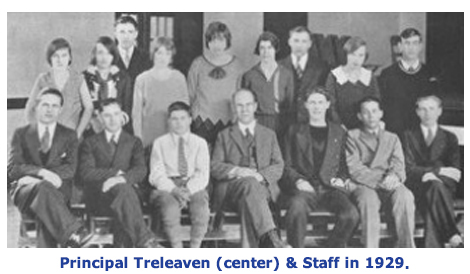
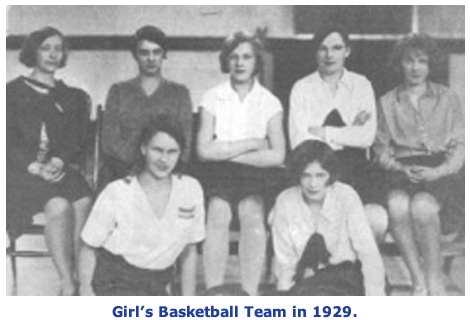
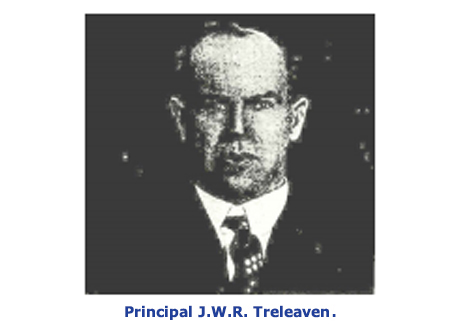
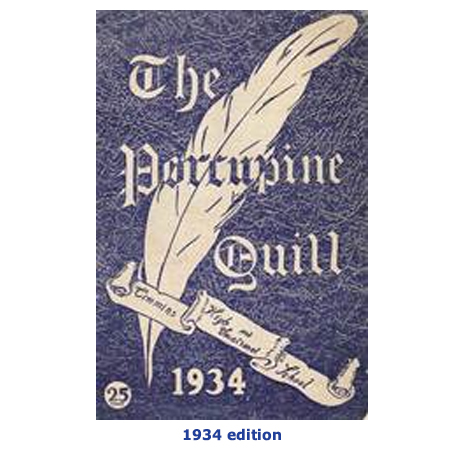
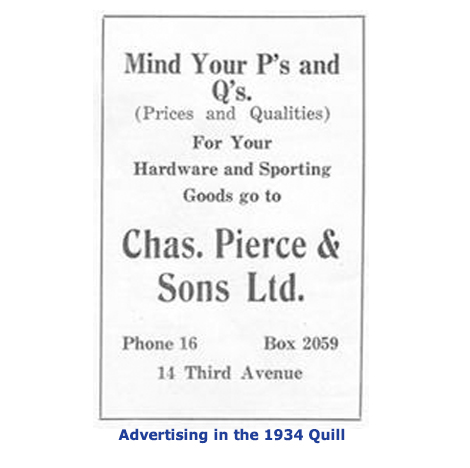
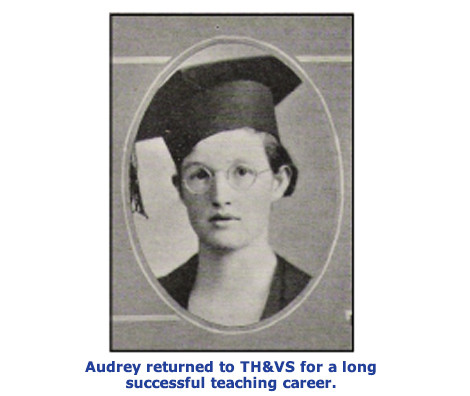
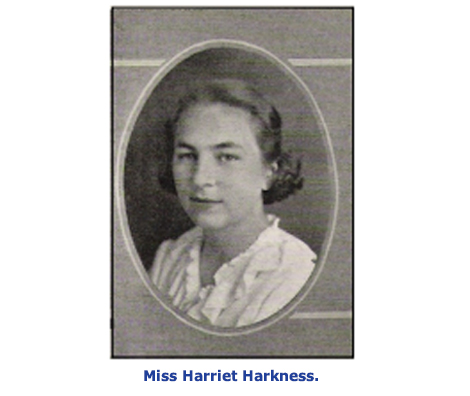
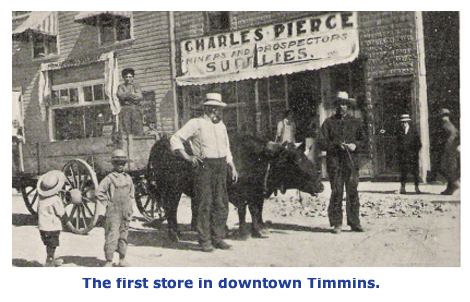
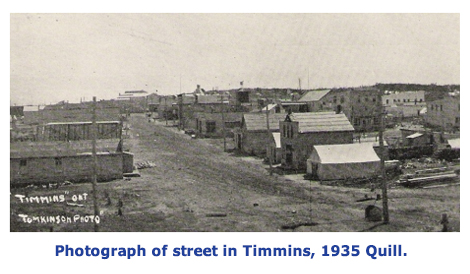
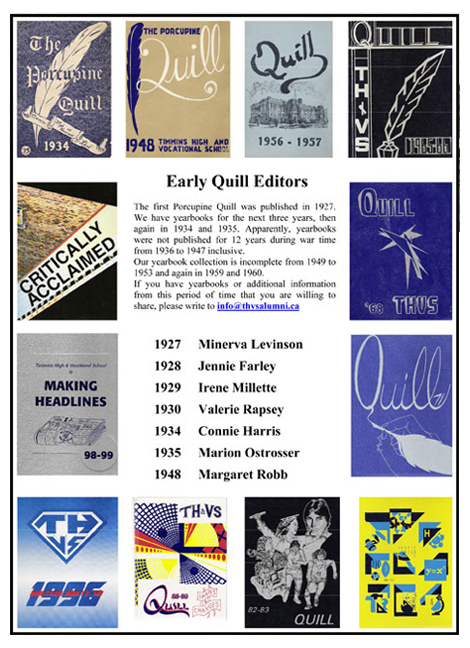
40's & 50's
The Forties - The War Years
Written by Colin Sellar for the Homecoming 198 Yearbook
When I joined the staff of TH&VS back in 1941, J.L. Murray was my Principal and
A. A. Rose was second in command. When Mr. Murray resigned in 1943 to become
Principal of the Kingston Collegiate Institute, Mr. Rose became the next Principal
of TH&VS and O. E. Walli was appointed to become his Vice Principal. When Mr. Walli left to become Principal of the Haileybury School of Mines, Mr. Runnalls
took over his duties as vice principal. From then until 1959, when Mr. Rose retired
after a very successful career in the teaching profession, Messrs Rose and Runnalls
were the administrators of the school.
Other members of the staff in 1941 were Misses Black, Bradley, Briffet, Carthy,
Cunningham, Davis, Evans, Gallagher, Gowan, McDonald, McGarry, McLaughlin, Mulvahill, Quinn, Richards, Smythe, Unger, and the Messrs Bowden, Brunton,
Carriere. A number of teachers joined the staff after 1941: Miss McGill, Miss
Routliffe, Miss Sharpe, Miss Tripp, Mr. Coons, Mr. Clarke, and Mr. Stonehouse. To
those I have missed, please accept my apologies.
Our day began at 9:00 am and was over at 4:00 pm with an hour and a half for lunch. There were nine thirty-five
minute periods a day. Any staff member who had one spare per week was indeed most fortunate. I don’t recall
that the students fared any better.
The school then, as now, was composed of three sections: academic commercial and technical. The technical
course had four shops – drafting, electricity, machine shop, woodwork and a mining room. At that time it was a
three-year course. Commercial was a four-year course and offered the following subjects: Bookkeeping, Household Science, Penmanship, Sewing, Business Law and Typing. Both commercial and technical students
were required to take other subjects such as English, Geography, History, Mathematics and Science to complete
their timetable.
During the war years, for a time, we had classes once a week from 3:00 to
4:00 pm in which subjects such as map reading, signaling, first aid, aircraft recognition, and small arms training were taught. A shooting range
was built in the basement and was used after school by both students and
teachers.
In those days as many will recall, we had one gym. Some of the boys’ physical education classes had to be taken in the basement because there
was no other space available. While in the basement, the boys were
instructed in army cadet drill and played some floor hockey. When the
boys had the auditorium, they used the stage, with the curtain drawn, for
their change rooms. The girls, in their turn, used the room west of the
Colin Sellar retired in
June 1962 after teaching
boys in the technical
program at TH&VS for
22 years.
On inspection at Hollinger Park
2
stage, which is now part of the guidance department. Not the best of dressing facilities, but we did manage.
In the early forties, because of the war, the equipment that we needed to carry on our physical education program
was very difficult to obtain. Consequently we guarded it well and had it patched many times in order to keep it in
use. For a time we were able to play twelve-man rugby with Schumacher, South Porcupine, Iroquois Fall and
Kirkland Lake. Later, because of war measures (gas and tire rationing) and because the smaller schools were
unable to field a twelve-man squad we switched to a six man game. A league was formed in which TH&VS
entered six teams and Schumacher and South Porcupine one each. The league was quite successful and lasted
until conditions improved.
In the late fall and winter, we played basketball. The
boys and girls each floored a junior and a senior
team. Our opposition was Schumacher, South
Porcupine, and Cochrane (we were able to travel by
train). There was always keen rivalry between the
schools, and we had some very exciting games.
In the spring we are able to play softball on the back
campus as long as our quota of bats and balls held
out. We continued to train our track and field
participants and were able to hold our track and field
meets either on the back campus or at the Hollinger
Park.
During the winter months some of the classes organized sleigh
ride parties which were popular, well attended and finished in
the auditorium where dancing, sandwiches and hot cocoa were
enjoyed by all. Other classes arranged for dances in the
auditorium as did the Students’ Council and the athletic
societies. I believe we held one formal dance per year. This
dance was one of the most important events of the year and was
well attended by both staff and students.
After the war, Mr. Carriere, Mr. Jackson and Mr. Hartman
returned to TH&VS to resume their teaching careers. Several
former students, after being discharged from the services, also
returned to complete their senior matriculation. Bill Carson,
John Boychuk, Cyril Ormston, Ron Taylor, Wilf Roy, and Dick Romualdi were some that I remember.
Senior Girls Basketball Team 1943
3
It wasn’t very long after 1945 that we were able
to order the athletic equipment we needed. Soon
our physical education program and our team
sports got into high gear.
We were able to resume our interschool activities
with schools in the area. Our senior rugby and
basketball teams, as well as the track and field
participants, were allowed to travel to New
Liskeard, North Bay and Sudbury to compete for
NOSSA Championships.
Remember the assemblies? They were held
every Friday morning during periods one and
two. The first and second form students attended the first assembly. They arrived in the auditorium accompanied
by the home form teacher and sat in a particular place. The remainder of the school came for the second assembly
and followed the same procedure.
For each assembly, the door at the back of the auditorium would open and Mr. Rose and Mr. Runnalls, accompanied by the guest or guests, would enter. Immediately all in the auditorium stood while they walked
down the aisle to the stage. The assembly remained standing to sing the National Anthem, and were seated while
Mr. Rose read several verses of scripture, then stood to repeat the Lord’s Prayer. Any announcement which was
necessary for the operation of the school was read.
Every class in each assembly was expected to arrange for one program during the year. Ross Clausi will
remember his first appearance on our stage playing his accordion. At the conclusion of the assembly, all stood to
sing “O Canada”. Then each class, accompanied by the home form teacher left the assembly, a row at a time, to
return to the respective homerooms for the first class of the day.
Since I kept no diary of my teaching career at TH&VS, my recollections of the Forties may not be too accurate. Please forgive the errors and omissions. I did, however, get some help from for TH teachers and who are living in
Timmins. To all the former and present teachers and students of good old TH&VS, may your future days be filled
with the good things in life and do have a wonderful time during Homecoming Weekend!
The 50's
Written by Mr. Doug Yeo, for the Homecoming 1980 Yearbook
Many of the alumni returning to Timmins for this reunion, after some period of
absence, are bound to find many changes in the community. Local residents find
the changes less startling. Since they have lived with them over the years, they
appear very gradual.
So too with TH&VS. While the physical plant changed very little during the
Fifties, the people within it did change. Most students spent five years or less in
high school. Each year a new batch of students comes into Grade Nine and, in
diminishing numbers, works its way through to graduation. There is a constant
flow of coming and going; the student body is never static. Expansion and
contraction of this group is often influenced by outside forces.
In Timmins, the price of gold remained static, technology improved, the local mines reduced their labor
forces, and families moved away, many to take advantage of new opportunities in Elliott Lake. Conversely, the conversion of the electrical system from twenty-five to sixty cycles and the building of
the Trans Canada Pipeline brought other families into the community briefly, and then they were gone
again. While this tended to have a greater impact on the elementary schools, it did make program
planning at TH&VS somewhat difficult.
The opening of the Don Bosco Intermediate School took a great many students at a time when expansion
would otherwise have been needed. While TH&VS was built in bits and pieces over the preceding
decades, the only addition during this one was the west wing which contained Gymnasium 119, the
change rooms and the Auto Shop beneath it.
Probably the most startling change during the decade was the staff. In the fall of 1950, there was a staff of
forty-five. Ten years later it had expanded to forty-nine; the big expansion came later. There was a
tremendous turnover. Teachers appeared to be very mobile. Of the forty-five here in 1950, fifteen
survived until 1960, six to 1970 and zero to 1980. Within each decade there were numbers of teachers
here for brief tenures. The surprising thing about this continuous turnover was the continuing
congeniality. Granted there were a few misfits, but all were welcomed, most made friends, and even after
short terms of stay, left with regrets and fond memories. There were regular social events: fall, spring and
sometimes midwinter stag and hen parties, full staff Christmas and farewell parties, and others on the
slightest pretext!
When the old-timers meet again, there is a great deal of: "Do you remember - the fishing party at
Chapman's Lake when Al...? the stag at Don Clarke’s cottage when...? the time at Cousineau's cottage
when...?"
The students also have their recollections. During this decade, football was a popular fall activity,
complete with snake dances through the town, cheerleaders, the big fire pot at Hollinger Park around
which everyone gathered at halftime, and the school dances after each home game.
There were two big dress-up dances a year: the Spring
Prom and the Snowball. These were real dress-up
occasions with the girls looking their prettiest in long
gowns, and the latest hair-do; the boys in suits - new or
let out to accommodate growth since the previous
occasion. And the music? By Henry Kelnick, of course!
There were a great number of student organizations:
Student Council, G.A.A., B.A.A., Hi-Y, Orchestra, Band, Choir, Cadet Corps, Debating Society, Public Speaking
Club, Library Club, Drama Club, Red Cross, Inter-School
Christian Fellowship, Tech Club and many others.
There was never any shortage of activity. Teachers often felt some
students were involved in too many, to the detriment of their
academic achievement.
Basketball, volleyball, track & field - all were opportunities for
social events whether the team won or lost – all the better if they
won.
What we remember most are the people! There were a number of
them and all were individuals. Do you remember the following
staff members?
Mr. Rose: Uncle Alec was tall and slim, almost cadaverous in appearance. While forced
by the pressure of increasing paper work to spend too much time in the office, he much
preferred to prowl the corridors, ensuring that things were running smoothly. His pet
peeve? Teachers involved in staff room discussions who forgot to get to class on time.
Mr. Runnalls: Howard was tall and slim. He tripled as math
teacher, math department head, and Vice Principal. Obviously, he was a very capable man. Students remember him as a very lucid teacher and a
consistent disciplinarian. Though very quiet and self-effacing in a group, he did
have a wry humor which became apparent over the bridge table. He was also a
great source of encouragement and advice to teachers and students.
Mr. Hilts: Alvin was here in the forties and early fifties. Besides being an outstanding and humorous
wood shop teacher, he was a marvelous woodcarver. He exhibited and sold at shows all across Canada. He would have a piece of wood or rock sitting in his wife’s way for weeks, while he studied it and
thought about it each time he passed it by. Then he would set to work, and in an amazingly short time, a
Dance in Gym 119
superb figure would emerge. Examples of his work can be seen in many of the Anglican churches of the
Diocese and the Churches of Moose Factory and Noranda.
Mr. Ed Bartlett: The music teacher was a lively little fellow who taught music appreciation, all the
instruments in the orchestra, and all the parts in the choir. In his spare time, i.e. after overtime choir, and
orchestra rehearsals and concerts, he gave private fiddle lessons, repaired instruments, worked in local
music organizations. When he was short of money, Ed rented the Palace Theatre and gave a violin concert
to a sellout audience. He married Eleanor Palmer, the sewing teacher in the room across the hall.
Miss Bourne: Audrey was, and still is, a little person physically. However, she dominated her classes!
Students knew they were in her room to learn some Biology. And learn they did. Her lab always seemed
to be piled high with student collections of weeds and bugs.
Mr. Brunton: Ray was the philosopher of the staff. He constantly tried to get the staffroom conversation
away from the frivolous and into deep conversation. Sometimes he succeeded. He always carried a brief
case which was seldom opened. Charlie Leppan once put a banana peel in it. Ray didn’t discover it for
three days.
Mr. Leppan: Charlie was the machine shop and tech director; he was obviously the great practical joker
of the staff.
Mr. Jury: Chester will probably be more remembered for his extracurricular
activities than his classes, although the latter were also entertaining. Many a
teacher has strode to the door to quell the noise in the corridor, only to discover
Ches and his students playing with the “Slinky”, officially to study wave motion. Ches’ forte was drama. He was involved in every student production and festival
that took place during his career. He also found time to act in Little Theatre. I still
vividly recall his “Charge” in Arsenic and Old Lace. If that were not enough, he
sang in the church choir, the Porcupine Choristers, and wrote poetry (Doggerel?)
for almost any occasion.
There were so many more. Lily Anderson, the extremely conscientious teacher of English. Harry
Birkenshaw, the math teacher who was the great organizer of student events including Hi-Y and Sea
Cadets. Don Clarke, the normally equable Phys. Ed. teacher who got terribly excited a football games. Bob Heath, who was supposed to be younger and calmer but turned out to be just as high strung at a
game. Bob Menard, the great organizer who would lose his cool over basketball. And Jean Cousineau,
who was outwardly old stone-face but inwardly, would be seething about an action on the basketball
court. Al Hartman, who could analyze every situation so clearly and concisely. And the peripatetic
Frenchman, Fernando Gauthier, - I never knew the meaning of the term until I met the little man who was
always on the move. B.J. Gowan, Lillie Quinn, Frances Evans, Irene Cunningham, Rita Seccombe. Must
not forget Peg Wilson, who started the fashion of bicycle riding.
It is harder to remember the students; there are so many of them. Many are recalled in connection with
some trait or accomplishment. There were the musicians like Bill Aide, Ross Clausi, Robert Hursti, Willie
Gasteiger, Lillian Natolino, and many more. The
golfers, Jo and John Ferrari. Jack Imber, who set so
many track and field records. Sandra Skene and Ann
Jones as figure skaters.
There were many great student leaders and organizers
such as Sheila Spooner, Ann Osborne, Peter Skully, Les Cohen and Lou Bennett. George Jonescu could get
up on the stage and whip up a great amount of
enthusiasm and get a tremendous turnout at a sporting
event, and even after a team had been clobbered, he
could turn around the next week and deliver a huge
crowd again.
These are only a few that I remember. Whom do you
remember?
50's Memories
Doo Wop Music in the 50's & 60's
Scroll - TH&VS Periodical 1956-57
Gold Pin Winner's of the 1950's

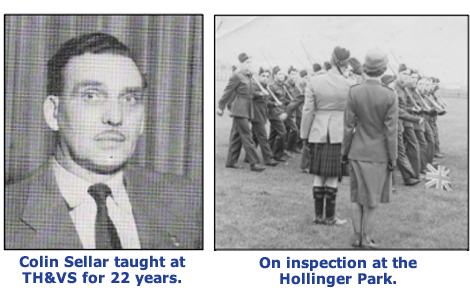
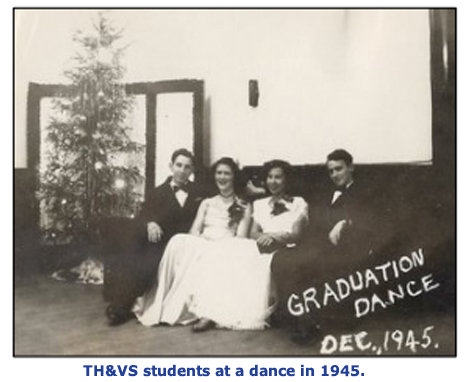
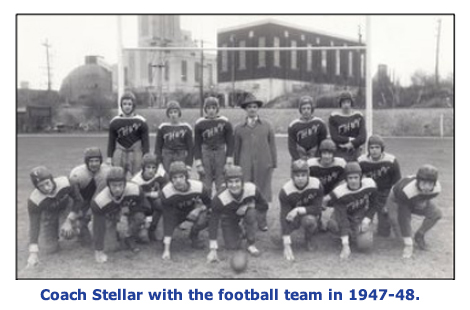
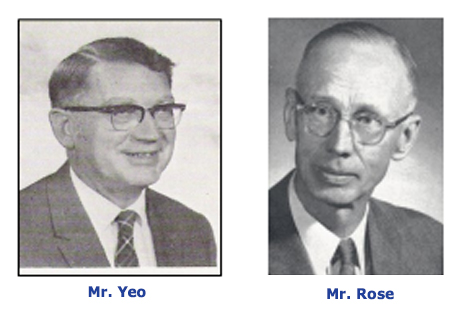
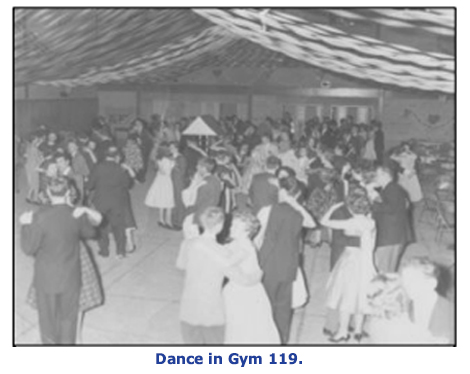
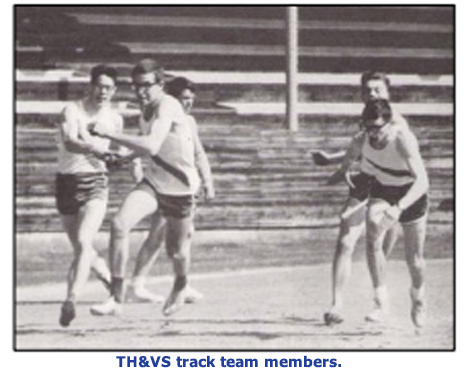
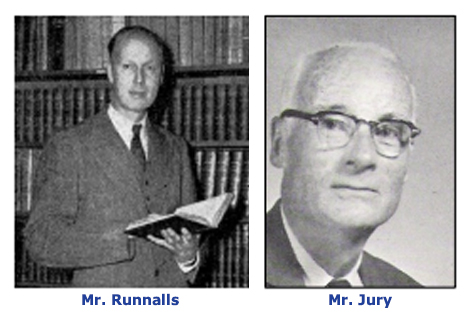
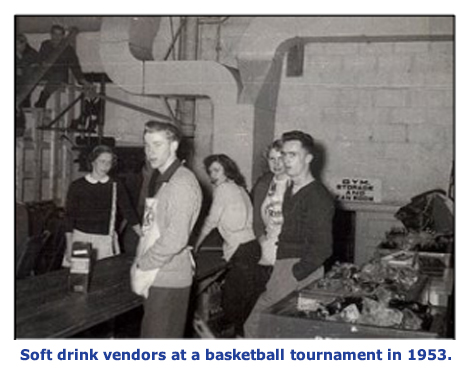
60's & 70's
The Sixties
Written by Maurice Bourdon, Frank Graf, et al, for the Homecoming 1980 Yearbook
The sixties provided the world with social and political
turmoil. Despite the apparent isolation of Timmins, staff members of that era plunged headlong into the
lifestyle of the day - and the result was a microcosm of
the decade (or if one prefers, a microcosm of the lunatic
fringe who stood at the vanguard of this progressive
society).
Who can forget Harry Nesbitt after an evening on the
town attempting to unlock the front door of his
residence with a lighter, only to be greeted by his
understanding wife. Frank Wood, the Latin instructor
answering the staff room phone with the words
“Buckingham Palace, King George speaking”, was
greeted with the voice of the Vice Principal Howard Runnalls who quipped:
"Excuse me, King, but I believe your class has been waiting your arrival for the
last ten minutes."
Former English teacher, Doug Craig called the same Howard Runnalls one fine
morning. It seems that Mr. Craig was quite ill and would not be reporting for duty. Mr.Runnalls wished
Mr. Craig a speedy recovery, and told him not to worry because not much was happening on this
particular Saturday morning.
Another Latin teacher, Jack St. John, would occasionally add spice to his classes by arriving in a toga. This classics major would also keep parties going by standing on the railings of second storey balconies
and threatening to end his existence in the fashion of Brutus, Cassius and Socrates himself. Jim
McNamara, our crew cut math teacher would consistently lecture
other staff members on the evils of tobacco and alcohol
addiction. These harangues were delivered as Mr. McNamara
was quaffing his nineteenth and twentieth “Cokes” of the day.
We wonder whether Joe “Alphabet” Zelicskovics can still spell
his name, and whether Ken Currie is still playing his ash-can
styled bass fiddle long into the nights, hours after he couldn’t
read music and couldn’t tell when a piece had ended.
Does Gene Burdenuk, our former Librarian at the desk in the
Allan G. Baker Library picture to the right, still have ski-doo
parties in London?
Does Jack McIlquham, our former plumbing instructor still warble the earthy folk
songs inspired by his close relationship with the sea, and friendship with other like- minded individuals who could be found in great numbers in a group known as the
British navy?
Does Colin Gosselin still use $300 worth of tape per season for his injured athletes?
Is George Luedekke still looking at the world objectively? Does Phil Betcherman,
the original jack rabbit, still eat a nutritionally-balanced and sensual meal? Has
Jim Alexander maintained his record of never having made a mistake in his life?
And finally, where are you, John Martin, our fine Biology teacher of years gone by? John’s laboratory
blackboard had a sign on which it instructed students to “Please Leave Your Stool on Top of Your Desk.”
John was also a communications expert obviously because each morning anyone within ten feet of his
door made a mad dash for the Pinesol.
The 60’s? California, Hippies, Yippies? The Chicago Seven? Woodstock? No. It was more fun here, and
these and many other staff members of the era made us take our lives a lot less seriously.
60's Memories
Extracurricular Activities in Gym 119, 1960's
Extracurricular Activities at Timmins High, 1968
Changes to Timmins High in 1968, Quill 1968
Gold Pin Winner's of the 1960's
Students' Administrative Council Presidents of the 60's
Quill Editors in the 1960's
The 70's - Saying Good-bye to the Old Timmins High
Principal's Message in the 1979-1980 Quill
This edition of “The Quill” has special signifi- cance because it may represent the last yearbook
publication to capture and reflect the activities in
our present Timmins High & Vocational School
building. The construction of the new school is
progressing well and it is anticipated that occupancy in our new building will take place sometime
during the 1980-81 school year.
The halls and rooms of the old TH&VS will
always be remembered and cherished with a
sense of warmth and fondness; memories of
happy times will long be associated with our
present building. Despite its age, our students
have treated TH&VS with pride and respect. Even though our building will be vacated and
become a remembrance, it will continue to be a
living reality in the minds of all those who lived
a significant part of their life in these hallowed
halls.
The departure from the old and the entry to the
new provides us with the opportunity to carry
meaningful traditions with us which will establish
that important thread of continuity with the
past. As well, it is significant that a new growth, a new beginning, occur with our passage to a
new building, our new home. The pride and
achievement that has been associated with our
school must be carried to the new with a sense
of responsibility that says:
"We are proud of our past; we will
build our new school with the spirit of the old, so that what has been achieved will not be lost, but will perpetuate in the activities and accom- plishments of the students of the new Timmins
High."
The yearbook reflects that particular spirit that
can serve as the foundation for the growth of our
new school. It is my hope that this publication
will serve as a visible record of what has thrived
in the past - and what will generate in the future
... our future in the new Timmins High & Vocational
School.
Robert L. Sampson, Principal
70's Memories
The Sound of Music at TH&VS
Broadway Musicals of the 1970's
The CN Tower Run, September 28 to 30, 1978
Gold Pin Winner's of the 1970's
Students' Administrative Council Presidents of the 70's
Quill Editors in the 1970's
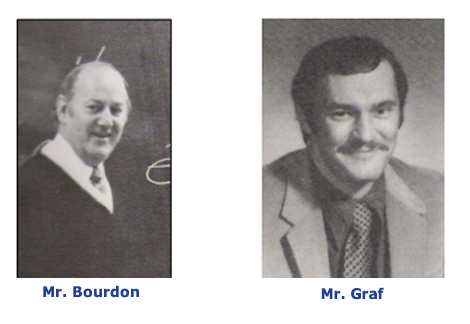
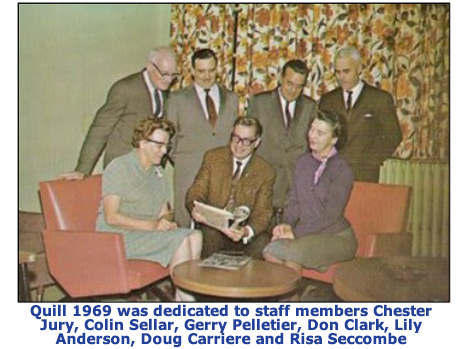
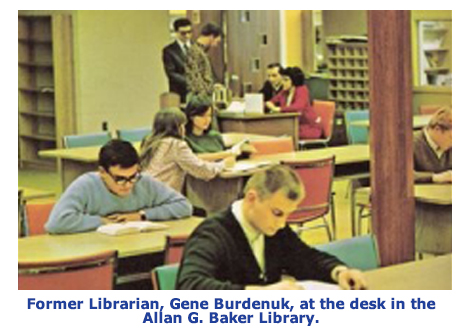
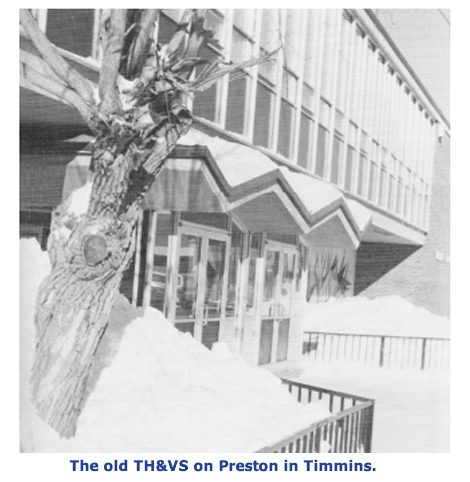
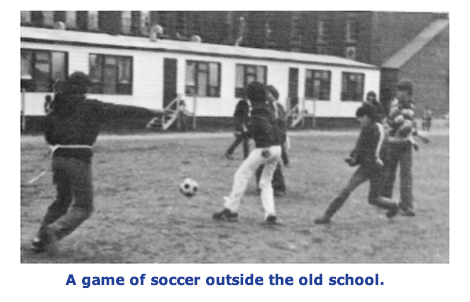
80's & 90's
Timmins High & Vocational School Opening Ceremonies
The official grand opening of the new TH&VS took place on May
29, 1981. On Friday night, a theatre night was held in the auditorium
with the Timmins Symphony Orchestra and Timmins Youth
Choir performing. The auditorium was officially opened and dedi- cated to the late Mr. William Dawson, a major fund-raiser for the
auditorium. Mrs. Dawson and her three children were present to
unveil the plaque.
On May 30, the school was opened to the public for viewing. Dr. Bette Stephenson, the Ontario Minister of Education, was present to
officially open the school and give it her blessing. In his speech, Principal Dan Andreatta said: "I extend sincere thanks to my vice
principals, my entire staff and my student body for their tremendous
effort and cooperation in both the planning of the new school and
the mid-year move to our new facility. Enjoy your new school!"
80's Memories
Construction of the New Timmins High, 1978 to 1980
The Many Faces of the New Timmins High, 1980
Staff Photos in the Quills of the 1980's
Student Activities, 1988-1989
Technical Program, 1980's
Timmins High Homecoming, 1923 to 1980
Gold Pin Winner's of the 1980's
Students' Administrative Council Presidents of the 80's
Quill Editors in the 1980's
From the Timmins High Grad Glass of 1992
Reprinted from the Quill, 1991-1992
When King Arthur set out on his quest for the
Holy Grail, he faced dark knights, French cows,
killer rabbits, bed wetting cohorts and appetiz-
ing minstrels.
When we set out on our journey through high
school, we faced similar obstacles: cafeteria
lines, stairwells (keep to the right please), toilet
paper ( if you can call it that), dances, how to fit
boots in your locker and establishing a place at
the rail. We faced many questions: “Boxers or briefs?” “Is silk too much
for school?” “Gravy?” “Who’s driving?” What’s going on this weekend?” “Do
you have any change?”. Then we grew up: “Euchre?”
We survived the masses and grew to become individuals. We shed our
lunch bags and inhibitions for MacDonald’s and friendships. Ours is a class
that has lived for the moment while looking to the future. Over the years
we’ve come to realize our needs and directions. Although we all have different
destinations, we’ll look back to this time we’ve spent together and
smile. Our Trivial Pursuits, May runs, welfare nights, cottage trips, Kids in
the Halls, Saturday Night Lives, Buzz’s pep talks and Adventures in Space
have inspired us to move forward and determine our own futures. These
destinations have yet to be reached, but wait on the horizon for us to venture
forth from our northern roots and wake up the rest of the world.
Life’s a good time, not a long time, so seize it while you can and remember
always the people who got you there. They say it’s a "me" generation. Let’s
prove them wrong.
The Quill, 1996-97
From the Desk of Darin Yanisiew, Editor of the 1996-1997 Yearbook
“Leaving an Impression is a term that comes to mind when one thinks of the wonderful year we had at Tim- mins High. Like every year, the students of Timmins High leave behind their impressions of the year, which is
reflected in the yearbook. I would like to leave behind my impression of the most memorable year of my life. Many people don’t realize how many people are required to produce an excellent yearbook. This year there
were 27 willing people in yearbook class, all of whom contributed their ideas. I must thank Mr. Adams, the
Yearbook advisor, for his leadership and help in producing this wonderful yearbook.
Being editor of the yearbook is a job for a selected few. It is a hard job that requires a lot of dedication and determination,
not to mention time. I want to say that being Editor this year has been the best year of my life!”
90's Memories
Curling at Timmins High, 1990's
Manufacturing Technology at TH&VS, 1990's
Staff Photos in the Quills of the 1990's
Gold Pin Winner's of the 1990's
Students' Administrative Council Presidents of the 90's
Quill Editors in the 1990's
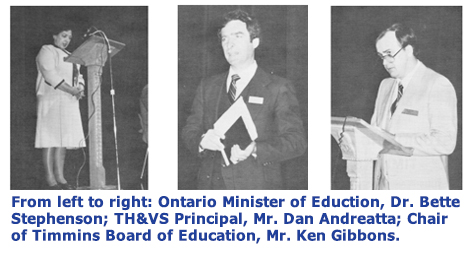
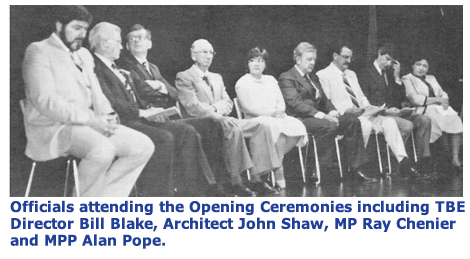
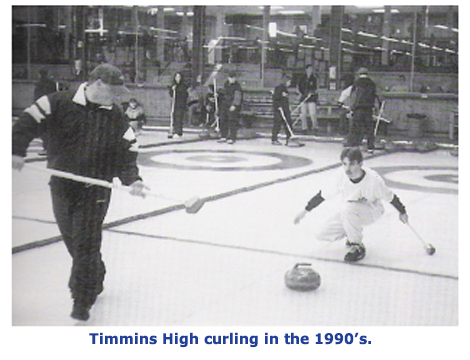
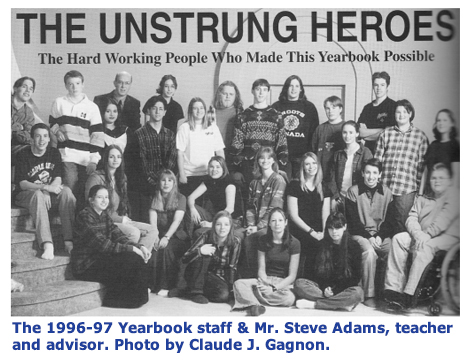
2000's
2000's Memories
Timmins High Supports Terry Fox Marathon of Hope
Timmins High Boys' Hockey, 2003-2004
Girls' Hockey at TH&VS, 2003-2004
Shania Twain Visits Timmins High
Program Choices at Timmins High
Food for Friends - Helping Make Christmas Special
Gold Pin Winner's of the 2000's
Students' Administrative Council Presidents 2000-2009
Students' Administrative Council Presidents 2010-2019
Quill Editors in the 2000's
